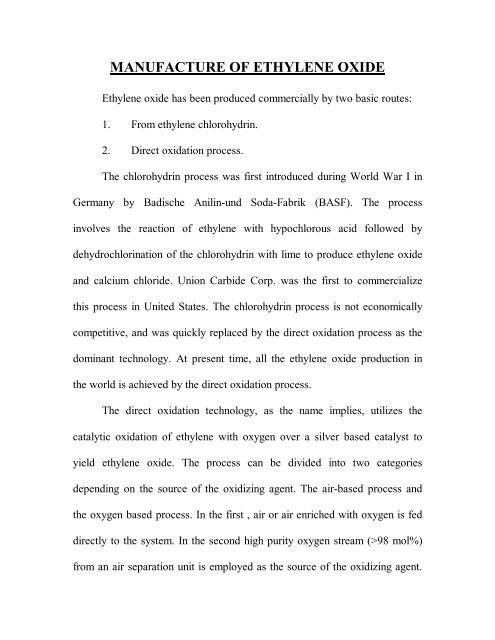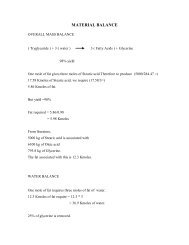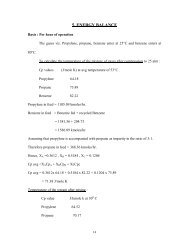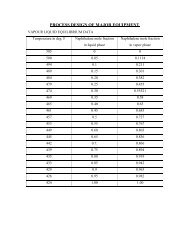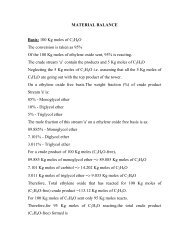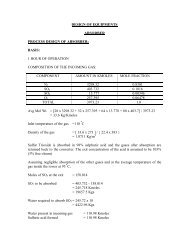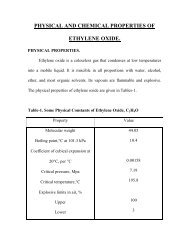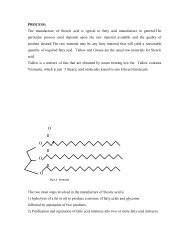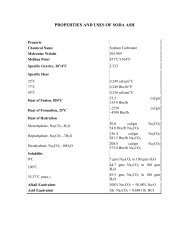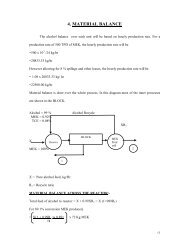Ethylene oxide Methods of Production
Ethylene oxide Methods of Production
Ethylene oxide Methods of Production
Create successful ePaper yourself
Turn your PDF publications into a flip-book with our unique Google optimized e-Paper software.
MANUFACTURE OF ETHYLENE OXIDE<br />
<strong>Ethylene</strong> <strong>oxide</strong> has been produced commercially by two basic routes:<br />
1. From ethylene chlorohydrin.<br />
2. Direct oxidation process.<br />
The chlorohydrin process was first introduced during World War I in<br />
Germany by Badische Anilin-und Soda-Fabrik (BASF). The process<br />
involves the reaction <strong>of</strong> ethylene with hypochlorous acid followed by<br />
dehydrochlorination <strong>of</strong> the chlorohydrin with lime to produce ethylene <strong>oxide</strong><br />
and calcium chloride. Union Carbide Corp. was the first to commercialize<br />
this process in United States. The chlorohydrin process is not economically<br />
competitive, and was quickly replaced by the direct oxidation process as the<br />
dominant technology. At present time, all the ethylene <strong>oxide</strong> production in<br />
the world is achieved by the direct oxidation process.<br />
The direct oxidation technology, as the name implies, utilizes the<br />
catalytic oxidation <strong>of</strong> ethylene with oxygen over a silver based catalyst to<br />
yield ethylene <strong>oxide</strong>. The process can be divided into two categories<br />
depending on the source <strong>of</strong> the oxidizing agent. The air-based process and<br />
the oxygen based process. In the first , air or air enriched with oxygen is fed<br />
directly to the system. In the second high purity oxygen stream (>98 mol%)<br />
from an air separation unit is employed as the source <strong>of</strong> the oxidizing agent.
Union Carbide Corp. was the first to commercialize an air-based direct<br />
oxidation process in 1937. The first oxygen-based system was<br />
commercialized by Shell Oil Co. in 1958. All the ethylene <strong>oxide</strong> plants that<br />
have been built during the last 15 years were oxygen-based processes and a<br />
number <strong>of</strong> plants were converted from the air to the oxygen-based process<br />
during the same period. The total world production capacity <strong>of</strong> ethylene<br />
<strong>oxide</strong> in 1992 was about 9.6X 10 6 metric tons. Most <strong>of</strong> the ethylene <strong>oxide</strong><br />
produced is consumed by its producers in making derivatives.<br />
The chosen process for this design thesis is the oxygen-based<br />
oxidation process, because this is the latest process for the production <strong>of</strong><br />
ethylene <strong>oxide</strong> production.<br />
DIRECT OXIDATION PROCESS:<br />
The phenomenal growth in United States and world ethylene <strong>oxide</strong><br />
production capacity since 1940 and the market trend toward larger singletrain<br />
plant is chiefly due to the commercial success <strong>of</strong> the direct oxidation<br />
process. Compared to the chlorohydrin process, direct oxidation eliminates<br />
the need for large volumes <strong>of</strong> chlorine. Also there are no chlorinated<br />
hydrocarbon by products to be sold, processing facilities can be made<br />
simpler, and operating costs are lower. The main disadvantage <strong>of</strong> the direct<br />
oxidation process is the lower yield or selectivity <strong>of</strong> ethylene <strong>oxide</strong> per unit
<strong>of</strong> feed ethylene consumed. The main inefficiency in the process results<br />
from the loss <strong>of</strong> 20-25 mol% <strong>of</strong> the ethylene to carbon di<strong>oxide</strong> and water.<br />
Consequently the operating conditions must be carefully controlled to<br />
maximize selectivity.<br />
All the ethylene <strong>oxide</strong> palnts are based on the original process<br />
chemistry discovered by Lefort in 1931.<br />
C 2 H 4 + ½ O2<br />
C 2 H 4 O<br />
The only significant by-products are carbon di<strong>oxide</strong> and water, which<br />
are formed either by complete combustion <strong>of</strong> ethylene:<br />
C 2 H 4 + 3O 2<br />
2CO 2 + 2H 2 O<br />
Or by further oxidation <strong>of</strong> ethylene <strong>oxide</strong>:<br />
C 2 H 4 O +2½ O2<br />
2CO 2 + 2H 2 O<br />
To prevent the further oxidation <strong>of</strong> ethylene <strong>oxide</strong>, the ethylene<br />
conversion is typically between 20-30% for ethylene <strong>oxide</strong>.<br />
In addition to ethylene <strong>oxide</strong>, carbon di<strong>oxide</strong>, water, small quantities<br />
<strong>of</strong> acetaldehyde and traces <strong>of</strong> formaldehyde are also produced. In this<br />
calculation this is neglected and assumed to go with the bottom products.
The total percentage <strong>of</strong> production <strong>of</strong> these compounds is 0.2% <strong>of</strong> the total<br />
ethylene <strong>oxide</strong> produced.<br />
A large amount <strong>of</strong> heat is released by the ethylene <strong>oxide</strong> reactions. At<br />
600 K, each Kg <strong>of</strong> ethylene converted to ethylene <strong>oxide</strong> releases 3.756 MJ;<br />
each Kg <strong>of</strong> ethylene converted to carbon di<strong>oxide</strong> and water releases 50.68<br />
MJ. Energy recovery and integration is a prime concern in process design.<br />
PROCESS DESCRIPTION:<br />
<strong>Ethylene</strong> (95-98% purity) and oxygen (air with 95 mole % <strong>of</strong> oxygen)<br />
are mixed in a ratio <strong>of</strong> 1:10 by weight and passed over a catalyst consisting<br />
<strong>of</strong> silver <strong>oxide</strong> deposited on an inert carrier such as corundum. Generally an<br />
anti catalyst such as ethylene dichloride (about 2% based on the weight <strong>of</strong><br />
ethylene) is added to the ethylene feed to suppress the formation <strong>of</strong> carbon<br />
di<strong>oxide</strong>. As an alternative vent gases form the absorber may be recycled to<br />
the reactor in such quantity as to keep the ethylene concentration in the feed<br />
at 3-5%. At a pressure <strong>of</strong> 4-5 atmosphere and temperature <strong>of</strong> 270-300°C,<br />
when a contact time <strong>of</strong> 1 sec is used, about 50 % <strong>of</strong> ethylene is converted.<br />
25% <strong>of</strong> the ethylene is converted to ethylene <strong>oxide</strong>.<br />
The effluent gases from the reactor are washed with water under<br />
pressure in an absorber. The ethylene is absorbed and sent to a desorber to<br />
desorb the water, which is used for the absorption. This water is recycled.
The overhead product from the desorber is sent to a steam stripper to remove<br />
the dissolved gases. The water- ethylene <strong>oxide</strong> mixture with small amount <strong>of</strong><br />
ethylene and other impurities are fed to a fractionating column to purify the<br />
ethylene <strong>oxide</strong> to 99 mole%.<br />
Commercial processes operate under recycle conditions in a packed<br />
bed multitubular reactor. The reactor is <strong>of</strong> shell and tube type comprised <strong>of</strong><br />
several thousand mild steel or stainless steel tubes, 20-50 mm inside<br />
diameter. The reactor can be either oil or boiling water-cooled. These tubes<br />
are filled with a silver based catalyst ca 3-10 mm diameter supported on a<br />
carrier material with surface area usually < 1m 2 /g. The yield (moles <strong>of</strong><br />
product formed per moles <strong>of</strong> ethylene consumed in the process) is normally<br />
70-80% depending on catalyst type, per pass conversion, reactor design and<br />
normally a large number <strong>of</strong> other process variables.<br />
OXYGEN BASED DIRECT OXIDATION<br />
Even though the fundamental reaction and the ultimate results are the<br />
same there are substantial differences in air and oxygen based processes.<br />
Virtually all the differences arise from the change in the oxidizing agent<br />
from air to pure oxygen (95 mole% O 2 ). Due to the low per pass conversion,<br />
the need for complete removal for ethylene <strong>oxide</strong> by absorption, and the<br />
accumulation <strong>of</strong> nitrogen in the cycle, the air process requires a substantial
purge stream. As a direct consequence <strong>of</strong> this air process requires the staged<br />
reaction- absorption system. The oxygen-based process uses substantially<br />
pure oxygen reduces the quantities <strong>of</strong> inert gases introduced into the cycle,<br />
and thereby results in almost complete recycle <strong>of</strong> the unreacted ethylene.<br />
This eliminates the need for purge reactor in the oxygen-based process.<br />
However the volume <strong>of</strong> the carbon di<strong>oxide</strong> formed is about 2 times the<br />
volume <strong>of</strong> the ethylene reacted at a catalyst selectivity <strong>of</strong> 70-80%. This CO 2<br />
must be eliminated on a continuous basis in order to control its concentration<br />
at an acceptable level in the cycle. Concentrations <strong>of</strong> CO 2 much in excess <strong>of</strong><br />
15-mole% adversely affect the catalyst selectivity. Therefore in oxygenbased<br />
process the recycled gas is treated in a CO 2 removing tower before it is<br />
send back to the reactor. The operation <strong>of</strong> the main reactor can be at much<br />
higher ethylene concentration than that possible in air-based process is much<br />
smaller than an air-based unit. The high ethylene concentration improves the<br />
catalyst selectivity because the per pass conversions are lower for a given<br />
ethylene <strong>oxide</strong> production.<br />
In the flow sheet <strong>of</strong> the shown the process is an oxygen-based process.<br />
<strong>Ethylene</strong>, oxygen, and the recycle gas stream are combined before entering<br />
the tubular rectors. The basic equipment used in this process is same as that<br />
used in air-based process. The purge reactor is not used in this process.
PROCESS TECHNOLOGY CONSIDERATIONS<br />
Innumerable complex and interacting factors ultimately determine the<br />
success or failure <strong>of</strong> a given ethylene <strong>oxide</strong> process. Those aspects <strong>of</strong><br />
process technology <strong>of</strong> the oxygen-based oxidation system are reviewed<br />
below.<br />
<strong>Ethylene</strong> <strong>oxide</strong> catalyst: Of all the factors that influence the utility <strong>of</strong> the<br />
direct oxidation process for ethylene <strong>oxide</strong>, the catalyst used is <strong>of</strong> the<br />
greatest importance.<br />
It is for this reason that catalyst preparation and research have been<br />
considerable since the reaction was discovered. There are four basic<br />
components in commercial ethylene <strong>oxide</strong> catalyst: the active catalyst metal;<br />
the bulk support; catalyst promoters that increase selectivity and/or activity<br />
and improve catalyst life; and inhibitors or anticatalysts that suppress the<br />
formation <strong>of</strong> carbon di<strong>oxide</strong> and water without appreciably reducing the rate<br />
<strong>of</strong> formation <strong>of</strong> ethylene <strong>oxide</strong>.<br />
The components <strong>of</strong> the catalyst are:<br />
1. The active catalyst metal- silver. A variety <strong>of</strong> methods are used for the<br />
preparation <strong>of</strong> the silver based catalyst on relatively inert supports.<br />
2. Bulk support- the supports used commercially are alumdum (a-alumina),<br />
silicon carbide. Other supports are glass wool, quartz, carborundum, and
ion-exchange zeolites. The physical and chemical properties <strong>of</strong> the<br />
support strongly dictate the performance <strong>of</strong> the finished catalyst. The<br />
surface area, porosity, and pore size <strong>of</strong> the support influence the size <strong>of</strong><br />
the silver particles on the support and, therefore, affect the performance<br />
<strong>of</strong> the final catalyst. High surface supports (3-100 m 2 /g) generally yield<br />
poor ethylene <strong>oxide</strong> catalysts presumably because ethylene reacts in the<br />
pores from which ethylene <strong>oxide</strong> is released slowly. The combination <strong>of</strong><br />
slow product release and poor heat conductivity <strong>of</strong> high surface area<br />
supports is claimed to result in the combustion <strong>of</strong> ethylene <strong>oxide</strong>.<br />
3. Promoters- alkaline earth metals. Silver alone on a support does not give<br />
rise to a good catalyst. However, addition <strong>of</strong> minor amounts <strong>of</strong> promoter<br />
enhances the activity and the selectivity <strong>of</strong> the catalyst, and improves its<br />
long-term stability. Excess addition lowers the catalyst performance. The<br />
most commonly used promoters are alkaline earth metals, such as<br />
calcium or barium, and alkali metals such as cesium, rubidium, or<br />
potassium. Using these metals in conjunction with various counter<br />
anions, selectivities as high as 82-87% were reported.<br />
4. Inhibitors- organic halides. Many organic compounds, especially the<br />
halides, are very effective for suppressing the undesirable oxidation <strong>of</strong><br />
ethylene to carbon di<strong>oxide</strong> and water, although not significantly altering
the main reaction to ethylene <strong>oxide</strong>. These compounds referred to as<br />
catalyst inhibitors, can be used either in the vapour phase during the<br />
process operation or incorporated into the catalyst manufacturing step.<br />
Important gas phase inhibitors are ethylene dichloride, ethylene<br />
dibromide, other alkyl halides, aromatic hydrocarbons, amines, and<br />
organometallic compounds. In a study <strong>of</strong> the effect <strong>of</strong> ethylene dichloride<br />
on catalyst activity, it was found that small amounts improved catalyst<br />
performance. In this design thesis the inhibitor suggested is ethylene<br />
dichloride.<br />
Operating pressure: Operating pressure has a marginal effect on the<br />
economics <strong>of</strong> the ethylene <strong>oxide</strong> process. High-pressure increases production<br />
due to higher gas density, increases heat transfer, increases ethylene <strong>oxide</strong><br />
and carbon di<strong>oxide</strong> recovery in the absorber, and lower the compression<br />
costs. Also, since the total number <strong>of</strong> moles decreases in the formation <strong>of</strong><br />
ethylene <strong>oxide</strong> from ethylene and oxygen, high pressure is consistent with<br />
high conversion. However high pressures reduce the flammable limit <strong>of</strong> the<br />
process gas as well as increase equipment costs. Typical pressures are 4-5<br />
atmospheres.<br />
Temperature and Thermal effects: Temperature is used to control two<br />
related aspects <strong>of</strong> the reaction: heat removal from the reactor bed and
catalyst operating temperature. The reactor temperature is controlled through<br />
the use <strong>of</strong> a heat-transfer fluid on the reactor shell. The coolant used in most<br />
recent designs is boiling water. Boiling water provides good heat transfer<br />
and improved safety over previous reactor designs using either boiling or<br />
circulation organic heat transfer fluids. Control <strong>of</strong> the catalyst operating<br />
temperature is necessary to prevent catalyst damage such as sintering or tube<br />
damage resulting from excessive temperatures in the catalyst bed. Localized<br />
hot spots <strong>of</strong> 100-300Û & DERYH WKH FRRODQW WHPSHUDWXUH FDQ IRUP LQ WKH<br />
catalyst bed without adequate temperature control.<br />
Heat removal from the reactor is necessary for stable operation. The<br />
reactor stability is affected by the internal temperature pr<strong>of</strong>ile in the tubular<br />
catalyst bed.<br />
Raw Material Purity Requirements: The oxygen process has four main<br />
raw materials: oxygen, ethylene, nitrogen (cyclic diluent), and inhibitor<br />
ethylene dichloride. The purity requirements are established to protect the<br />
catalyst from damage due to poisons or thermal runaway, and to prevent the<br />
accumulation <strong>of</strong> undesirable components in the recycle gases. The latter can<br />
lead to increased cycle purging, and consequently higher ethylene losses.<br />
Typical ethylene specifications call for a minimum <strong>of</strong> 99.85-mol% ethylene.<br />
The primary impurities are usually ethane and methane. A methane limit is
largely unnecessary; however, care should be taken to restrict the amount <strong>of</strong><br />
ethane since high ethane concentration will lead to increased chloride<br />
inhibitor concentration, which adversely affects the product quality, catalyst<br />
life and materials <strong>of</strong> construction. Impurities that strongly affect catalyst<br />
performance and reactor stability include acetaldehyde, propylene,<br />
hydrogen, and sulphur. Acetylene causes catalyst coking at very low<br />
concentrations. Carbonaceous deposits can also be caused by heavy<br />
hydrocarbons if present. Propylene is more reactive than ethylene and will<br />
oxidize to a wide range <strong>of</strong> products, including aldehydes that lower the<br />
product quality. Hydrogen and carbon mon<strong>oxide</strong> can be lead to hot spotting<br />
<strong>of</strong> the catalyst, and sulphur is a nonreversible poison for silver-based<br />
catalyst.<br />
Oxygen must be 95 mol% pure and rest is assumed to be nitrogen.<br />
Presence <strong>of</strong> argon is assumed to be negligible. Organic chloride<br />
specifications are less critical since the flows are significantly less.<br />
<strong>Ethylene</strong> Oxide Recovery: An economic recovery scheme for a gas stream<br />
that contains less than 3 mol% ethylene <strong>oxide</strong> must be designed. It is<br />
necessary to achieve nearly complete removal since any ethylene <strong>oxide</strong><br />
recycled to the reactor would be combusted or poison the carbon di<strong>oxide</strong><br />
removal solution. Commercial designs use a water absorber followed by
vaccum or low pressure stripping <strong>of</strong> ethylene <strong>oxide</strong> to minimize <strong>oxide</strong><br />
hydrolysis.<br />
<strong>Ethylene</strong> <strong>oxide</strong> purification: The main impurities in ethylene <strong>oxide</strong> are<br />
water, traces <strong>of</strong> carbon di<strong>oxide</strong>, acetaldehyde and formaldehyde. The water<br />
and heavy ends are removed in the distillation column, which works under<br />
atmospheric pressure. Acetaldehyde and formaldehyde are assumed to be<br />
present in PPM level.
Use Pattern<br />
END USES OF ETHYLTNT OXIDE<br />
This estimate was made in the year 1995.<br />
Use<br />
Percent<br />
<strong>Ethylene</strong> glycol 64<br />
Glycol ethers and polyglycols 11<br />
Detergents 10<br />
Ethanolamines 8<br />
Acrylonitrile 5<br />
Miscellaneous 2<br />
100<br />
<strong>Ethylene</strong> <strong>oxide</strong> is an excellent fumigant and sterilizing agent.<br />
<strong>Ethylene</strong> <strong>oxide</strong> is used as an antimicrobial pesticide to fumigate. Species and<br />
to sterilize medical devices, such as sutures, bandages, endoscopes and<br />
cardiac pacemakers. Most medical devices in the USA are sterilized using<br />
EO. <strong>Ethylene</strong> <strong>oxide</strong> sterilization process requires relatively low temperatures<br />
and pressures, and does not damage the materials or packaging being<br />
sterilized.<br />
<strong>Ethylene</strong> <strong>oxide</strong> sterilant gases are supplied as liquefied compressed<br />
gases, either pure or as a mixture with a flame retardant. When supplied as a
pure gas, the ethylene <strong>oxide</strong> is shipped in special insulated containers. For<br />
safety reasons, nitrogen gas is added to the vapour phase up to a total<br />
pressure <strong>of</strong> a345 Kpa (50 psig) at 21°C. When used in a sterilizing chamber,<br />
the flammability <strong>of</strong> ethylene <strong>oxide</strong> is usually controlled by purging the<br />
sterilization chamber with nitrogen gas at the beginning and the end <strong>of</strong> the<br />
sterilization process. In some cases, the effects <strong>of</strong> a potential deflagration are<br />
moderated by operating under great vacuum or, in the case <strong>of</strong> small hospital<br />
sterilizers, by using very small quantities <strong>of</strong> ethylene <strong>oxide</strong>.<br />
<strong>Ethylene</strong> <strong>oxide</strong> has been studied for use as a rocket fuel and as a<br />
component in munitions. It has been reported, ethylene <strong>oxide</strong> to be used as a<br />
fuel in FAE (fuel air explosive) bombs.<br />
HEALTH AND SAFETY FACTORS<br />
Mutagenetiuty, Neurotoxicity & General Toxicological factors <strong>of</strong> <strong>Ethylene</strong><br />
<strong>oxide</strong>.<br />
TOXICOLOGY:<br />
An excellent review <strong>of</strong> the toxicity and health assessment <strong>of</strong> ethylene<br />
<strong>oxide</strong> has been compiled. <strong>Ethylene</strong> <strong>oxide</strong> (EO) can be relatively toxic as<br />
both a liquid and gas. Inhalation <strong>of</strong> ethylene <strong>oxide</strong> in high concentrations<br />
may be fatal. Estimates <strong>of</strong> lethal ethylene <strong>oxide</strong> inhalation levels in animals
depend on the duration <strong>of</strong> exposure. The reported 4-h LC50 values for rats,<br />
mice, and dogs are 1460, 835, and 960 ppm, respectively. More recent<br />
information indicates that the 1-h LC50 in rats is approximately 5000 ppm.<br />
Inhalation exposure to high concentrations <strong>of</strong> ethylene <strong>oxide</strong> has been<br />
reported to result in respiratory system irritation and edema. Depending on<br />
the degree <strong>of</strong> exposure, there may be stinging <strong>of</strong> the nose and throat,<br />
coughing, and chest tightness. Also, exposure may cause lung injury and<br />
delayed onset <strong>of</strong> pulmonary edema. In long-term studies <strong>of</strong> animals exposed<br />
to less than 100 ppm <strong>of</strong> ethylene <strong>oxide</strong> and in human studies, no evidence <strong>of</strong><br />
injury has been reported for the cardiovascular system, liver, or kidney.<br />
There is some evidence that occupational exposure to high levels <strong>of</strong> ethylene<br />
<strong>oxide</strong> can result in cataracts.<br />
Neurological effects have also been reported in association with<br />
recurrent human and animal inhalation exposures to ethylene <strong>oxide</strong>. Again,<br />
depending on the degree <strong>of</strong> exposure, headache, nausea, vomiting, diarrhea,<br />
dizziness, loss <strong>of</strong> coordination, convulsion, or coma may occur. The onset <strong>of</strong><br />
illness is rapid in severe exposures, but may be delayed after moderate<br />
exposure.
In the reports <strong>of</strong> human peripheral neurotoxic effects or central<br />
nervous system toxicity, most cases have shown a marked improvement on<br />
removal from further exposure.<br />
<strong>Ethylene</strong> <strong>oxide</strong> has been shown to produce mutagenic and cytogenic<br />
effects in a variety <strong>of</strong> test systems. An increased frequency <strong>of</strong> chromosomal<br />
aberrations in peripheral lymphocytes <strong>of</strong> monkey exposed to ethylene <strong>oxide</strong><br />
for 104 weeks has been reported. In mice, it is an effective inducer <strong>of</strong><br />
chromosome breaks leading to dominant-lethal mutations.
THERMODYNAMICS AND KINETICS OF<br />
REACTIONS<br />
The two reactions taking place in the manufacture <strong>of</strong> ethylene <strong>oxide</strong><br />
from ethylene in direct oxidation is given below.<br />
C2H4 + ½ O2<br />
C2H4 + 3O2<br />
C2H4O ------Æ (A)<br />
2CO2 + 2H2O ---Æ(B)<br />
Temperature range <strong>of</strong> the reaction = 250-300ºC<br />
Pressure range in the reactor = 4- 5 atmospheres.<br />
Table: 2.1 Specific Heat Data <strong>of</strong> the components:<br />
Cp/R = A + B*T + C*T 2 + D*T -2<br />
T is the temperature in Kelvin.<br />
Component A B*10 3 C*10 6 D*10 -5<br />
C 2 H 4 1.424 14.394 -4.392 ------<br />
C 2 H 4 O -0.385 23.463 -9.296 ------<br />
O 2 3.639 0.506 ------ -0.227<br />
CO 2 5.457 1.045 ------ -1.157<br />
H 2 O 3.470 1.450 ------ 0.121
Table: 2.2 Energy Data <strong>of</strong> components at temperature <strong>of</strong> 298 K:<br />
Component<br />
û+ºf (J/ K mole)<br />
10 7 K) 10 5 10 7<br />
û6ºf (J/ K mole û*ºf (J/ K mole)<br />
C 2 H 4 5.2510 2.1920 6.8440<br />
C 2 H 4 O -5.2630 2.4299 -1.3230<br />
O 2 0 2.054 0<br />
CO 2 -39.3510 2.1638 -39.4370<br />
H 2 O -24.1814 1.8872 -22.850<br />
The enthalpy <strong>of</strong> formation at the reaction temperature can be calculated<br />
using the following equations.<br />
û+ T û+ ÛI 298K + R X œû &S5 G7-----Æ (1)<br />
:KHUH û+ T is the enthalpy <strong>of</strong> formation <strong>of</strong> the reaction at the reaction<br />
temperature T is the temperature and R is the universal gas constant. The<br />
integration limits are from 298 K- T K.<br />
û+ T û+ ÛI 298K 5>û$7 û%7 2 û&7 3 /3 - û'7 -1 ]---Æ (2)<br />
Entropy <strong>of</strong> the reaction is calculated using the following equations.<br />
û6 T û6 ÛI 298K + R X œû&S57 G7 ---Æ (3)
:KHUH û6 T is the entropy <strong>of</strong> the reaction at the reaction temperature. T is<br />
the temperature and R is the universal gas constant. The integration limits<br />
are from 298 K- T K.<br />
û6 T û6 ÛI 298K 5>û$OQ 7 û%7 û&7 2 /2 - û'7 -2 /2]---Æ (4)<br />
Table: 2.3 Thermodynamic data for the reaction: A<br />
Temperature,<br />
K<br />
û+ -/K mole<br />
10 -6 û6 -. PROH-K<br />
û* -. PROH<br />
10 -3 10 -6<br />
523 -106.47 -80.10 -64.578<br />
533 -106.49 -85.94 -60.7<br />
543 -106.51 -86.10 -59.76<br />
553 -106.54 -86.13 -58.91<br />
563 -106.54 -86.21 -58.00<br />
573 -106.55 -86.28 -57.11<br />
Calculation for the table: 2.3<br />
û+ ÛI 298K û+ ÛI 298K C 2 H 4 O - >û+ ÛI 298K C 2 H 4 – û+ ÛI 298K O 2 ]<br />
= (-5.2630 – 5.2510 - 0)* 10 7<br />
= -105.14*10 6 J/K mole<br />
û6 ÛI 298K û6 ÛI 298K C 2 H 4 O - >û6 ÛI 298K C 2 H 4 – û6 ÛI 298K O 2 ]<br />
= (2.4299 – (2.1920 – ½* 2.0504))* 10 5
= -78.73 * 10 3 J/K mole – K<br />
û+ 523 û+ ÛI 298K + R X œû &S5 G7<br />
The temperature limit is from 298 K- 523K. On integration and supplying<br />
the limits,<br />
û+ 523 =[-105.14*10 6 + 8314*(-3.6285*(523 – 298) + (8.816*10 -3 /2)<br />
*(523 2 -298 2 ) – (4.904*10 -6 *((523 3 -298 3 )/3) – 0.2207*10 5 *(1/523 –<br />
1/298)]<br />
= -106.47*10 6 J/ K mole.<br />
û6 523 û6 ÛI 298K + R X œû &S57 G7<br />
The temperature limit is from 298 K- 523K. On integration and supplying<br />
the limits,<br />
û6 523 = [-78.73*10 3 + 8314*(*(-3.6285*(ln (523) – ln(298)) + (8.816*10 -3 )<br />
*(523-298) – (4.904*10 -6 *((523 2 -298 2 )/2) – (0.2207/2)*10 5 *(1/523 2 –<br />
1/298 2 )]<br />
= -80.10*10 3 J/ K mole – K<br />
û* û+ – 7û6<br />
= -106.47*10 6 + 523*80.10*10 3<br />
= -64.578*10 6 J/K mole
Table:2.4 Thermodynamic data for the reaction: B<br />
Temperature,<br />
K<br />
û+ -. PROH û6 - . PROH-<br />
10 -9<br />
û* - . PROH<br />
K<br />
10 -9<br />
10 -3<br />
523 -1.324 -31.85 -1.307<br />
533 -1.324 -32.00 -1.307<br />
543 -1.324 -32.16 -1.3065<br />
553 -1.324 -32.32 -1.3061<br />
563 -1.324 -32.48 -1.3057<br />
573 -1.324 -32.64 -1.3053<br />
Calculation for the table: 2.4<br />
û+ ÛI 298K û+ ÛI 298K &2û+ ÛI 298K H2O - >û+ ÛI 298K C 2 H 4 –1/2*<br />
û+ ÛI 298K O 2 ]<br />
= 2* -39.3510*10 7 + 2* -24.1814*10 7 - [5.2630*10 7 + 2*0]<br />
= -1.323*10 9 J/ K mole<br />
û6 ÛI 298K û6 ÛI 298K &2û6 ÛI 298K H2O - >û6ÛI 298K C 2 H 4 –1/2*<br />
û6 ÛI 298K O 2 ]<br />
= 2*2.1368*10 5 + 2* 1.8872* 10 5 – [2.1920*10 5 +<br />
3* 2.0504*10 5 ]
= -29.52*10 5 J/ K mole – K<br />
û+ 523 û+ ÛI 298K + R X œû &S5 G7<br />
The temperature limit is from 298 K- 523K. on integration and supplying the<br />
limits,<br />
û+ 523 =[-1.323*10 9 + 8314*(4.089*(523 – 298) - (10.922*10 -3 /2)<br />
*(523 2 -298 2 ) +(4.392*10 -6 *((523 3 -298 3 )/3) + 1.391*10 5 *(1/523 –<br />
1/298)]<br />
= -1.324*10 9 J/ K mole.<br />
û6 523 û6 ÛI 298K + R X œû &S57 G7<br />
The temperature limit is from 298 K- 523K. On integration and supplying<br />
the limits,<br />
û6 523 = [-29.52*10 3 + 8314*(*(4.089*(ln (523) – ln (298)) - (10.922*10 -3 )<br />
*(523-298) + (4.392*10 -6 *((523 2 -298 2 )/2) + (1.391/2)*10 5 *(1/523 2 –<br />
1/298 2 )]<br />
= -31.85*10 3 J/ K mole – K<br />
û* û+ – 7û6<br />
= -1.324*10 9 + 523*31.85*10 3<br />
= -1.307*10 9 J/K mole
Calculation <strong>of</strong> equilibrium constant for the two reactions:<br />
û* -R*T*ln (K)<br />
û* . DUH WKH IUHH HQHUJ\ FKDQJH DQG HTXLOLEULXP FRQVWDQWV UHVSHFWLYHO\<br />
For the first reaction; û* 1 = -R*T*ln (K 1 )<br />
Therefore;<br />
-64.578*10 6 = 8314*523*ln (K 1 )<br />
K 1 = 2.8*10 6<br />
For the second reaction; û* 2 = -R*T*ln (K 2 )<br />
-1.307*10 9 = 8314*523* ln (K 2 )<br />
K 2 = ’<br />
Since the equilibrium constant <strong>of</strong> the second reaction is K 2 =’ 7KH UHDFWLRQ<br />
is irreversible and the conversion is found to be 0.995 or 99.5%.<br />
Calculation <strong>of</strong> conversions <strong>of</strong> the reactions:<br />
It is assumed that initially there are 3.5 moles <strong>of</strong> oxygen and 2 moles<br />
<strong>of</strong> ethylene are present. Initially the product concentration is assumed to be<br />
zero.
Table: 2.5 Equilibrium constant and conversion.<br />
Temperat<br />
ure<br />
K 1 *10 -6 K 2 Conversion,<br />
/<br />
Conversio<br />
n<br />
/<br />
523 2.8 ’ 0.995 0.995<br />
533 0.8 ’ 0.995 0.995<br />
543 0.561 ’ 0.995 0.995<br />
553 0.367 ’ 0.995 0.995<br />
563 0.24 ’ 0.995 0.995<br />
573 0.161 ’ 0.995 0.995<br />
Table: 2.6 Mole balance table.<br />
Component,<br />
C2H4 C2H4O CO2 O2 H2O #<br />
(i)<br />
(j) 1 -1 1 0 -0.5 0 -0.5<br />
2 -1 0 2 -3 2 0<br />
Mole fraction <strong>of</strong> the component = y = (n + n i / j )/( Q + #/ i,j )<br />
Q LV WKH WRWDO LQLWLDO QXPEHU RI PROHV Q LV WKH LQLWLDO QXPEHU RI PROHV<br />
<strong>of</strong> the particular species.
yC 2 H 4 = (2-/- /- /<br />
yC 2 H 4 O<br />
yO 2<br />
yCO 2<br />
yCO 2<br />
/ -0.5* /<br />
= 3.5- /- / - /<br />
/ - /<br />
/ - /<br />
Ky 1 = [products] a /[reactants] b<br />
=yC 2 H 4 O/(yC 2 H 4 )* (yO 2 ) 0.5<br />
=/ - / / - / [3.5- /- / - /@ 0.5<br />
Kp1 = K 1 = Ky 1 * P ûQ ---Æ (5)<br />
3 LV WKH SUHVVXUH LQ DWPRVSKHUHV ûQ LV WKH WRWDO QXPEHU RI PROHV<br />
Ky 2 = [products] a /[reactants] b<br />
= (yCO 2 ) 2 *(yCO 2 ) 2 /(yC 2 H 4 )* (yO 2 ) 3<br />
=[ / - /@ 2 > / - /@ 2 / / - / [3.5-<br />
/- / - /] 3<br />
Kp2 = K 2 = Ky 2 * P ûQ ----Æ (6)<br />
From equation (5) & (6)<br />
/ <br />
/ <br />
Theoretical conversion for the reactions is 99%. Bu the practical conversion


